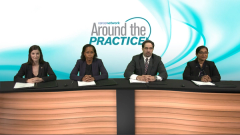
CAR T-Cell Therapy in Transplant-Ineligible Patients with MM
Nausheen Ahmed, MD, and Al-Ola Abdallah, MD, discuss the use of CAR T-cell therapy in patients with transplant-ineligible multiple myeloma.
Episodes in this series

Transcript:
Al-Ola Abdallah, MD: Nausheen, we’re not going to go to the other case without talking about CAR [chimeric antigen receptor] T-cell [therapy] for transplant. I think this is something we are seeing some trials on. Any thoughts about that? We’re not talking about transplant. We’re talking about the daratumumab-Revlimid [lenalidomide]-dexamethasone, especially some newer trials that we’re going to talk about that later on [with] the efficacy of the CAR T-cell and the safety. Do you think we’re going to have some future in CAR T-cell and [eligibility] for transplant, especially upfront?
Nausheen Ahmed, MD: Yes. I think that the world of myeloma is getting very exciting now with these new immune effector cell therapies and CAR T-cell therapies since they’ve come out. Even though now they’re just only in the relapsed/refractory setting. There is the CARTITUDE-5 trials in which they’re looking at upfront CAR T-cell therapies in transplant-ineligible patients, those that don’t want to [get] transplant, or we who don’t deem are not fit for transplant. So that’s going to be an interesting trial and seeing the results of that.
There’s also the upfront setting, even though this patient might not necessarily be eligible for it. If you were transplant eligible, there’s a trial that’s actually looking at transplant or CAR T-cell therapy. There would be an arm [in the trial for that]. There’s the CARTITUDE-6 trial in which you get the induction, then you either get transplant with maintenance or you get CAR T-cell therapy onwards. So those are some exciting trials. In the next few years, [we’ll] get the results of these trials and see what’s the role of transplant and where CAR T-cell therapy fits into this picture in the upfront setting. And honestly, CAR T-cell therapy might be easier to tolerate in some of these frail patients. So we have many patients that we think may be ineligible for transplant that might still be eligible for CAR T-cell therapy. I think it’s a game changer, or it will be in the future, but we’ll see how things go.
Al-Ola Abdallah, MD: And this prompts my question, I don’t want to be the person who missed that. If CAR T-cell therapy is there in a newly diagnosed myeloma [patient] will maintenance be that in the clinical trial? Are they going to opt not to give maintenance therapy?
Nausheen Ahmed, MD: Yeah. That’s yet to be seen.
Al-Ola Abdallah, MD: OK. Because that’s what we’re talking about with quality of life. I hate to say the word game changer as much as I like it. I will say if you’re going to give CAR T-cell therapy without maintenance, that’s a game changer.
Nausheen Ahmed, MD: That’s correct.
Al-Ola Abdallah, MD: A game changer. And that’s going to be the one I will say is the optimal treatment. Telling the patient that I’m giving you a CAR T-cell therapy and there’s nothing else after that. That’s where it’s all a game changer.
Transcript edited for clarity.
Newsletter
Stay up to date on recent advances in the multidisciplinary approach to cancer.







